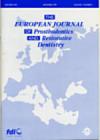European Journal of Prosthodontics and Restorative Dentistry

- Cover Date:
- March 2006
- Print ISSN:
- 0965-7452
- Vol:
- 14
- Issue:
- 1
Variability Of Centric Relation Position In TMD Patients
Abstract - Reproducibility of the centric relation position for patients with temporomandibular disorders (TMD) is not documented in the current literature. It was the objective of this study to assess clinical variability of the centric relation position for TMD patients with a muscle-determined technique by means of an anterior deprogramming device, the leaf gauge. A sample of 60 patients with signs of TMD was selected, 8 men (Mean age 28,6, SD 5,2) and 52 women (Mean age 30,5, SD 10,1). All patients were examined with the Research Diagnostic Criteria, including pain on movement and/or function, mouth opening, joint sounds and palpation of masticatory muscles. All 60 patients were allocated to one of the following diagnostic subgroups: myofascial pain, disk displacement with reduction, disk displacement without reduction, osteoarthritis, trauma. Twelve control subjects were taken from a previous study. Three sequential centric relation records were taken; the ï¬rst one was used to mount a set of casts to an articulator. Criteria of precision were formulated beforehand: 2 out of 3 centric relation records had to be identical in a split-cast procedure. Variables XL and XR represented mandibular displacement in the sagittal plane, variables YL and YR in the transversal plane, and ZL and ZR in the vertical plane, on the left and right condylar level respectively. Variables XMIN, YMIN and ZMIN represented the minimal sagittal, transversal and vertical displacement left or right respectively. Likewise, variables XMAX, YMAX and ZMAX represented the maximal sagittal, transversal and vertical displacement left or right. XDIFF, YDIFF and ZDIFF represented the difference between the minimal and maximal values of X, Y and Z. The diagnostic subgroup trauma was excluded, because there was only one patient. The null-hypothesis of no between-group differences in within-subject and total variability was tested with an analysis of variance (ANOVA). The level of signiï¬cance was set at 0.05. To minimize type I errors caused by multiple testing Scheffe’s test was used to maintain an overall signiï¬cance of 0.05. No signiï¬cant difference between patients and control subjects could be found for variables XL, XR, YL, YR, ZR and ZL. Variables XMIN, YMIN, ZMIN, XMAX, YMAX, ZMAX, XDIFF, YDIFF and ZDIFF showed no signiï¬cant differences. Scheffe’s testing for the variables XL, XR, YL, YR, ZL and ZR, as well as the variables XMIN, YMIN, ZMIN, XMAX, YMAX, ZMAX, XDIFF, YDIFF and ZDIFF showed no signiï¬cant differences. The results of this study suggest no variability in centric relation position between TMD-patients and control subjects by means of the leaf gauge.
KEY WORDS: Centric Relation, TMD, Lea/gauge
- Article Price
- £15.00
- Institution Article Price
- £
- Page Start
- 32
- Page End
- 37
- Authors
- A.J.J. Zonnenberg, J. Mulder
Articles from this issue
- Title
- Pg. Start
- Pg. End
- Effect of Five Staining Solutions on the Colour Stability of Two Acrylics and Three Composite Resins Based Provisional Restorations
- 2
- 6
- Surface Microhardness of a Resin Composite: a Comparison of a Tungsten Halogen and a LED Light Curing Unit, in vitro
- 7
- 12
- The effect of cooking method upon the titratable acidity of a popular vegetarian dish – Scope for reducing its erosive potential?
- 28
- 31
